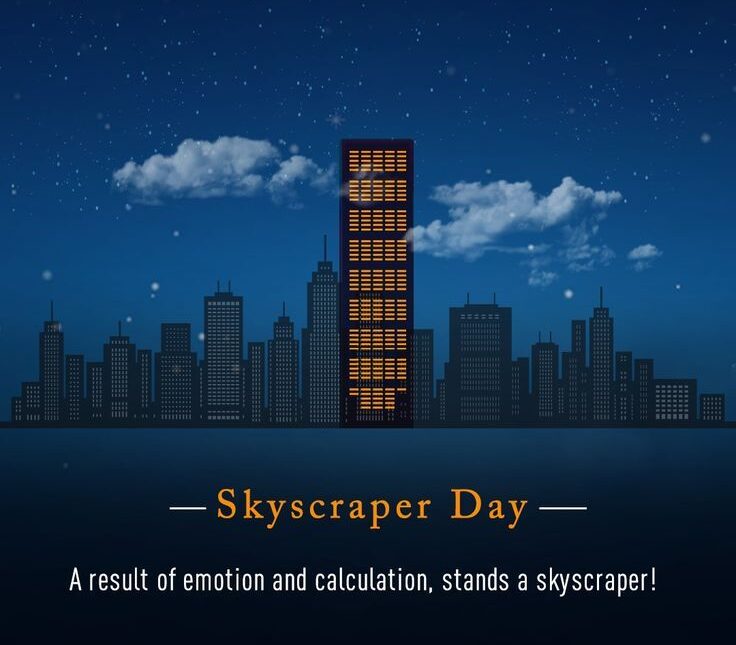🏗️ Introduction: Why Skyscraper Day Deserves a High Place in Our Hearts
Every time we look up at a towering skyscraper — whether it’s the shimmering Burj Khalifa or the historical Empire State Building — we don’t just see steel and glass. We see vision, ambition, and human courage. Skyscraper Day, celebrated every year on September 3rd, is a special occasion to admire humanity’s architectural marvels and honor the pioneers who dared to build beyond the clouds.
- 🏗️ Introduction: Why Skyscraper Day Deserves a High Place in Our Hearts
- 🕰️ History of Skyscraper Day
- 🗓️ Timeline of Key Moments in Skyscraper History
- 🌆 9 Awe-Inspiring Facts About Skyscrapers
- 🤔 FAQs About Skyscraper Day
- 🎯 Significance of Skyscraper Day
- 🧠 Daily Life Impact of Skyscrapers
- 🌍 Observing Skyscraper Day Around the World
- ✨ Wishing Messages for Skyscraper Day
- 🧱 Why Skyscrapers Are Important to Society
- ✅ Key Takeaways
- 🏁 Conclusion: The Skyline Is Not the Limit
This article dives deep into the history, significance, amazing facts, global observance, emotional impact, and why skyscrapers are more than just tall buildings — they’re vertical dreams made real.
🕰️ History of Skyscraper Day
Skyscraper Day is celebrated on September 3rd in honor of the birth of Louis H. Sullivan (1856–1924), a renowned American architect known as the “father of skyscrapers.”
He wasn’t just a structural genius, but a philosopher of form, believing that “form follows function.” Sullivan’s design principles laid the foundation for modern skyscraper architecture and mentored none other than Frank Lloyd Wright.
Though there is no official founding organization for Skyscraper Day, its observance gained popularity in architectural communities and educational circles in the late 20th century, growing to be appreciated by the general public as well.
🗓️ Timeline of Key Moments in Skyscraper History
| Year | Event |
|---|---|
| 1885 | Home Insurance Building in Chicago is built — considered the first skyscraper (10 stories). |
| 1931 | Empire State Building completed — tallest building at the time. |
| 1973 | World Trade Center Twin Towers become tallest buildings in the world. |
| 2004 | Taipei 101 takes the crown from the Petronas Towers. |
| 2010 | Burj Khalifa opens in Dubai, soaring to 828 meters, still the tallest. |
| Today | Dozens of skyscrapers exceed 500 meters, redefining urban skylines. |
🌆 9 Awe-Inspiring Facts About Skyscrapers
🏙️ The First Skyscraper Was Only 10 Stories Tall
The Home Insurance Building in Chicago (1885) was only 138 feet (42 m) tall — a baby compared to today’s giants, but revolutionary at the time.🌍 Burj Khalifa Is Taller Than 2 Eiffel Towers Stacked Together
Standing at 828 meters (2,717 ft), it’s nearly 3x the height of the Empire State Building!🧱 Skyscrapers Are Built to Sway
These towers are not rigid — they’re designed to sway during wind and earthquakes, some up to 2 meters!💡 Tall Buildings Reduce Urban Sprawl
By building vertically, cities reduce the need to expand horizontally, preserving natural spaces and improving urban density.🌆 China Has the Most Skyscrapers in the World
As of 2025, Shenzhen, China has the most skyscrapers (over 150 high-rises above 200m), more than New York or Dubai.🌬️ Wind Load Is More Important Than Weight
Skyscraper engineering is less about holding the weight and more about withstanding powerful wind forces.⛑️ Many Skyscrapers Use Tuned Mass Dampers
Devices like the 688-ton damper in Taipei 101 help reduce vibrations during typhoons and earthquakes.💰 They Cost Billions to Build
For example, the Abraj Al-Bait Clock Tower in Mecca cost over $15 billion, making it one of the most expensive buildings ever.🌇 Skyscrapers Reflect Cultural Identity
Each city’s skyline — from New York’s rectangular power to Kuala Lumpur’s twin harmony — reflects its people’s vision and values.
🤔 FAQs About Skyscraper Day
Q1: Why is Skyscraper Day celebrated on September 3?
It’s the birthday of Louis Sullivan, a foundational figure in skyscraper design.
Q2: Is Skyscraper Day an official international holiday?
No, it’s more of a symbolic and educational observance celebrated by architecture lovers, engineers, and urban planners.
Q3: How tall must a building be to be considered a skyscraper?
Technically, buildings over 150 meters (492 ft) are classified as skyscrapers.
Q4: Can skyscrapers be environmentally friendly?
Yes! Many now incorporate green architecture: solar panels, rainwater harvesting, and sustainable materials.
Q5: What’s the purpose of celebrating Skyscraper Day?
To inspire innovation, celebrate architecture, and recognize the achievements in urban development and engineering.
🎯 Significance of Skyscraper Day
Inspires Future Builders: Encourages students and dreamers to pursue architecture, design, and engineering.
Appreciates Innovation: Honors creative thinking and technical mastery.
Promotes Urban Sustainability: Reminds us of the importance of smart cities and vertical development.
Celebrates Human Ambition: Reflects our endless quest to touch the skies.
🧠 Daily Life Impact of Skyscrapers
You might not live in one, but skyscrapers still impact your city’s economy, environment, and skyline.
🏢 Creates business hubs in compact areas
🌳 Preserves land by building upward
🚶♂️ Encourages public transit and walkability
💼 Attracts multinational businesses, creating jobs
🎨 Adds aesthetic and pride to cities
For example, Mumbai’s Lodha World One or New York’s One World Trade Center aren’t just tall buildings — they’re symbols of resilience and progress.
🌍 Observing Skyscraper Day Around the World
While not as widely commercialized as other days, many institutions and cities observe it creatively:
🏛️ Architecture schools host seminars or workshops
🖼️ Exhibitions of iconic skyscraper models and blueprints
📱 Social media campaigns with hashtags like #SkyscraperDay, #TallestBuildings, #SkylineLove
🎥 Documentaries or short films highlighting local urban stories
🧒 Kids participate in Lego skyscraper challenges or art projects
✨ Wishing Messages for Skyscraper Day
You can inspire others with these thoughtful words:
🏙️ “Here’s to the architects who teach us to reach higher — Happy Skyscraper Day!”
🧠 “A skyscraper begins with a single vision. Keep building your dreams!”
🏗️ “Celebrate those who dared to stack stories into the sky. Happy Skyscraper Day!”
🌇 “May your ambitions rise as tall and bold as a skyscraper!”
🎨 “To the dreamers of skylines — your imagination shapes the world. Cheers!”
🧱 Why Skyscrapers Are Important to Society
🏙️ Cultural Identity: They shape the visual identity of cities.
👩🔬 Innovation Catalyst: Push boundaries in material science, engineering, and design.
🌎 Sustainable Urbanization: High-rises reduce sprawl, traffic, and pollution.
🧍♂️ Maximized Utility: More people and functions fit into smaller footprints.
📸 Tourist Attractions: Iconic towers attract visitors, boosting tourism and economy.
Without skyscrapers, cities would be less efficient, more sprawled, and far less inspirational.
✅ Key Takeaways
📅 Celebrated every 3rd September to honor Louis H. Sullivan
🏙️ Skyscrapers = modern marvels of ambition and precision
🌎 Impact economy, environment, and urban life
🧠 Inspire architects, engineers, and the next generation
💡 A moment to appreciate what we build — and why we build it
🏁 Conclusion: The Skyline Is Not the Limit
Skyscraper Day reminds us that human limits are often self-imposed. From humble beginnings to awe-inspiring towers, the journey of skyscrapers mirrors the evolution of mankind itself.
Next time you walk past one, pause. Look up. Not just to admire the height, but to reflect on the heights we can achieve with vision, courage, and unity.
🔝 Because skyscrapers don’t just rise — they lift entire cities, spirits, and futures.








